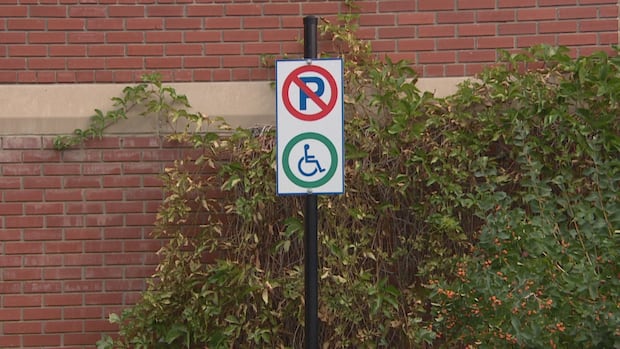Jenna Sittler said she fears logging onto social media platforms like Reddit and Facebook after seeing posts of people shaming and judging others for “abusing” accessible parking spaces.”I would have an anxiety attack if that was directed at me,” she said.Jenna Sittler was diagnosed with chronic pain, fatigue and dysphonia in 2013. She said she is often met with “blatant stares” when she parks in an accessible stall, with people assuming she doesn’t need it because she is “too young” or doesn’t “look disabled.”Before her diagnosis, she spent five years in extreme pain as she juggled work with what felt like endless doctors appointments, x-rays and scans. Sittler said she spent all of those years convincing her doctors, boss, co-workers and even friends that her condition is real, and it is frustrating having to do the same with complete strangers.”It’s like they need that confirmation, they need to see it,” she said. “I don’t want to have to use what little I have to defend myself to people that won’t ever understand.”Jenna Sittler was diagnosed with chronic pain, fatigue and dysphonia in 2013. (Chanss Lagaden/CBC)Sittler said she often chooses to park further away, exhausting herself, or cut her errands short so she doesn’t have to deal with negative interactions. She said she only uses accessible parking stalls on days she is “really, really, really limping” or “barely upright” due to a flare up.”I feel safer to park there because then people can see this,” she said.”People just kind of treat you subhuman when you’re disabled.”Quick to judgeBart Harder said he understands why people often glare at him. From the outside he appears able-bodied.Harder sustained a spinal cord injury in 1998. He could still walk and do most things after the incident, but the injury slowly progressed over the years. He has now lost the full use of his right shoulder and both hands.”But I’m not a quad in a wheelchair,” he said. “If I tell somebody that my hands don’t work, they don’t … you know, it doesn’t mean anything to them, because I can still walk.”Harder said he felt “dumb” applying for his parking permit.”I didn’t want to tell the world, yeah, I got crippled because I … I don’t feel crippled,” he said. “Until you walk into Walmart or Costco or, you know, when you’re stumbling out to your car because your legs are buckling under you.”Bart Harder sustained a spinal cord injury in 1998. He now has lost full use of his right shoulder and both of his hands. (Chanss Lagaden/CBC)Harder said people are quick to judge what they can’t see. He said he has been called out on using an accessible stall many times.”In the store, you know, as you’re walking around, you always feel like somebody’s watching you,” he said.He said more people need to understand that these parking permits are given for a reason. “I’m not here because [SaskAbilities] just felt terrible and thought they’d give me a [permit],” he said.Permit misuse rare: SaskAbilitiesMore than eight million Canadians live with a disability, according to a 2022 Statistics Canada report.Carrie McComber, director of rehabilitation services for SaskAbilities, said there isn’t one specific disability that makes someone eligible for a disability parking permit. She said the main criterion used is someone being unable to walk unassisted for more than 50 metres.”They can’t walk that distance without great difficulty, or it’s a danger to their health and safety,” McComber said.She said there are three basic types of permits: one year, three years and lifelong. There is an extensive application process and a medical professional has to fill out a form on the applicant’s behalf.”What is the challenge for that particular individual?” she said. “It could be a short-term disability such as a broken leg. It could be a longer-term disability where maybe they’re recovering from surgery and the recovery is expected to take, you know, a year or more.”People with shorter-term permits who don’t recover in the expected time-frame have to go back to their medical professional and go through the application process again.McComber said the permit holder doesn’t need to be driving the vehicle.”We have many children who obviously don’t have licences that have permits.”While a permit could be used by someone who doesn’t need it, she said it’s rare. She said she sometimes gets reports about people allegedly abusing a permit.”Probably nine times out of 10, the majority of times, there’s no issue with the permit,” she said.McComber said many people misunderstand what a disability can be, especially when it’s invisible.”There are heart conditions, there’s clients that are legally blind, there are cognitive disabilities, there’s so many other factors that could put a person in danger if they have to walk long long distances,” she said. “Just because you can’t see it doesn’t mean it’s not there.”A nuanced communityJonathan Tremblay’s life was turned upside down in 2019 when his youngest son was diagnosed with a rare genetic neuromuscular disorder. Autosomal recessive spastic ataxia of Charlevoix-Saguenay (ARSACS) affects the spinal cord and nerves responsible for body movements, balance, speech and co-ordination.Tremblay said the pandemic gave him a lot of time to think about what life would look like going forward.”I started wondering, what am I going to do about this? Do I get a research degree and start doing what I can?” he said.Tremblay’s motivation to learn evolved into a passion for advocating for his son, “but also the large proportion of Saskatchewan that does experience disability.”He joined the board of directors for SaskAbilities and is now the chair for the accessibility advisory committee in Regina.”It’s about better understanding this community, because all I have is my son,” he said.Jonathan Tremblay’s son was diagnosed with with autosomal recessive spastic ataxia of Charlevoix-Saguenay (ARSACS) in 2019. (Submitted by Jonathan Tremblay)Tremblay said many people have a stereotype of what it means to have a disability.”It’s a person that wears their disability on the outside and almost wears a flag saying, ‘I am all disabled people,'” he said.Tremblay said accessible parking is one area where stigma often appears. He said he has been confronted many times about using an accessible parking spot, because he doesn’t have a disability himself.”I don’t experience this disability, but I certainly have a placard, because I pick up my son and his wheelchair at school, at daycare, at the museum,” he said.”I would gladly park further if it met my son didn’t have a lifelong degenerative disability that prevents him from walking from that far or dragging his wheelchair through the mud.”Tremblay said society still often treats disability as if, “there’s no nuance there, whereas the community is extremely nuanced.”He said many people with disabilities are leading industries, growing jobs and the economy, using facilities, paying taxes and voting.”People experiencing disabilities are also people in many other ways,” Tremblay said. “They don’t define themselves by that one thing, but everyone wants to put them in that bucket.”He acknowledged that many people think they are advocating for people with disabilities by confronting those they deem as “abusing” an accessible parking stall. “Conversely, someone that is going to be confronted with the reality of their disability, especially if it’s an invisible one, doesn’t want to go through that and may park further and impact their own quality of life to avoid that confrontation,” he said. “We’re isolating these people even more than they already are.”
People with invisible disabilities fear judgement and online hate when parking in designated spots











